History of the Purple Monster Acropora
by Steve Tyree
Published January 1st 2015
Hello Reeffers,
And I mean the coral reefers, not the... well you know what. Thought I would do
a little write up and explain how the Purple Monster coral came into the captive
coral reef market. And also how the whole Limited Edition exotic naming of corals
began. Saw someone was reading and commenting on my old Dynamic Ecomorphology
Purple Monster page. That page has not even been updated in 10 years. Was taking
care of 8 web sites for awhile and that number is down to just 4 now. So yeah,
the old DE web site is still up there, but way out of date. Also the current
Reeffarmers page is out of date. Will get to it when I get some time. This article
was originally posted on my Facebook Timeline, but since those articles can get
lost over time, decided to update, edit, expand and repost that article here.
If you would like to add comments, please find the Facebook thread on my timeline.
Back when the PM was imported, (1995 from the Solomon Islands), the keeping of
Acropora within the US was just beginning. The very first Acropora colony sold in
a store was in my reef tank at the time and had grown in captivity to about
2 feet x 1 3/4 feet x 1 1/2 feet in size. It was acquired around June 1992 and was
only available because of a bet between the store owner and his exporting Indonesian
relative. The bet was to see if Acropora could be shipped alive. So by the summer
of 1995, we were three years into keeping Acropora colonies in the US. And yes most
were not very colorful. We did experiment with the colorful Loripes from Fiji in
1993 and 1994, but were running into KH issues and the first KH crashes. So there
was not a whole lot of color beyond brown and green available.
Me and two other aquarists from the Laguna Hills California area, decided to try buying a
box of Solomons Transhipped Acropora through Aquatic Depot. Getting in Acropora
from anywhere but Indonesia was still rare. And the initial Fiji Loripes colonies
were very colorful, but proved difficult for the captive market at the time. The
A. loirpes are very sensitive to KH issues and you could not even buy calcium reactors
back then in the US. In fact I later beta tested the second Calcium Reactor unit even
made for distribution within the US (MKR-1 made by Bob Mankin). So that is where we
were technology wise when I picked up that Aquatic Depot tranship order. The workers
at Aquatic Depot were very excited when they showed me the Solomon Islands box. They
said it was the best box of corals they had ever seen. There were 4 medium to
large PM colonies in the box.
Unfortunately the corals were roughed up fairly bad and only one of those colonies
ended up surviving past the first week. The largest one of the box, which I had placed
in my tank. Eventually the Purple Monster recovered from shipping stress and began to
show its first growth. I did not call it the Purple Monster (PM) and initially did not
like that name. But it was what everyone else called it, so the name stuck. There was
no way in the world I was going to frag the coral for anyone at the time. Fragmenting
Acropora was still just getting started and no one really had a clue how to do it
properly with guaranteed success.
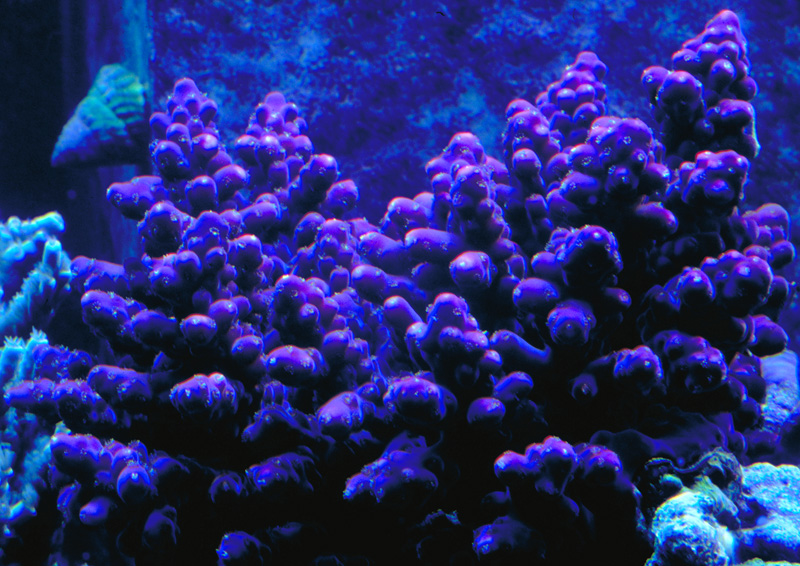
It had barely survived the transhipping alive, but once it recolored up it looked
quite fantastic. Here the Purple Monster had been in captivity
for a few weeks and
had recovered quite nicely. This turned out to be a strong light coral and the
reef it was placed within was one of the first
to be using the
400 watt 20,000 K Radium Metal Halides. Dana Riddle metered the PAR value at
the surface at well over 900 micro Einstein.
It was the highest reading he had metered over
a captive reef at that time. Image is of the left half of the colony.
A few months later I got hooked up with a major coral importer and for awhile was
the number one Acropora transhipper in the country. Stores were buying colonies
direct from me. Then it all fell apart as things tend to do over time. The first
coral disease hit the captive market called RTN within about 6 months to a year of
the arrival of the Purple Monster coral. And this was a very virulent strain of RTN.
At the time we figured we did not even have to worry about diseases, pests or predators.
Heck we were just learning how to keep them alive and growing. The RTN problem was so bad
that it ended up affecting the entire small polyped stony coral industry, which
afterwards became a shell of itself for a year or two.
Unfortunately I could not tell people about the RTN problem publicly. Was actually
threatened with a law suit if I ever spoke about the disease in public. This was
around 1996. Dynamic Ecomorphology eventually failed and I thought the failure at
the time was primarily due to the RTN problem. Little did I know at that time that
a few of the industry insiders were telling everyone that RTN came from my facility
only. It had actually come from Fiji. So yes, my first company Dynamic Ecomorphology
went down in flames because of those issues. Now that I look back at that whole
fiasco, Dynamic Ecomorphology was more or less sacrificed for the hobby. Eventually
Fiji worked out their issues and people began keeping Acropora again. The good news
was the Purple Monster survived. Older established captive corals had exhibited
better success fighting off the newly imported RTN infection.
And eventually people figured out that my facility was not the only source of the
problem, since people who did not buy Acro colonies through me, also got RTN. I however was
struggling badly due to the failure of DE. Hooked up with Bill Schroer who owned
Piece of the Reef in Rancho Cucamonga. Bill and Tapio Haaparanta and Cameron Azad and
even Mike Paletta eventually convinced me into fragging the Purple Monster. Initially
the first few frags were just done for these select good customers and they were not
charged much. Probably around $20 to $30. Back then everyone wanted colonies and buying
fragments was not common at all. Bill will later convince me to resell his purple monster
fragments for $50 or more each. Thought he was nuts when he first suggested that resale
price. Who was going to pay $50 for an Acro frag ? At the time you could buy a small
colony for $40 to $50 retail.
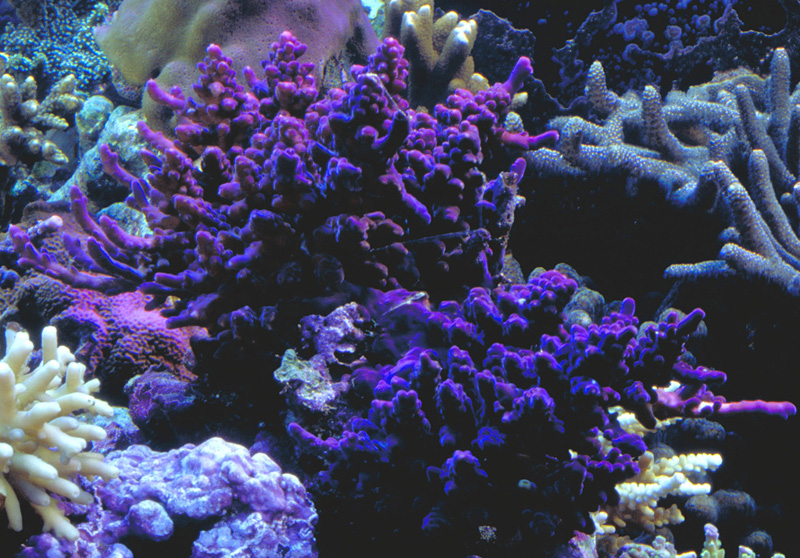
The coral began growing a few months after recovery. This was obviously
a shallow water coral that needed strong light and strong current.
Some aquarists had
trouble getting the coral to color up well in their captive systems. They were either
using weak to moderate lighting systems
or bulbs that emitted poor spectral output.
This image shows the left half and right half of the original colony. Note that no frags were done.
Eventually financial pressures and Bill Schroer convinced me to give it a go. Listed
his PM frags for $50 or more resale to my email list and people started buying them.
Bill was right and there was a market for $50 and up fragments. We did not use the term
Limited Edition back then and had just called them exotic frags. It would be a few years
later that the Reeffarmers web site began and we started marketing Limited Editions.
That is when the real LE craze took off. And it was crazy back then. When I listed a new
LE coral, my phone would ring more or less non stop for up to two hours. People would get
mad at me if they did not get a timely reservation. Very wierd situation. But the good
news was that a sizeable market for captive SPS coral frags existed and was being born.
Over the years I have come to realize that what people wanted was a product they
could grow themselves and sell with a good marketing name. It ended up being a consumer
driven phenomenon. And just look at what the consumers have created today. Granted
some of it is now out of hand, but its birth was not meant to be out of hand. And
unfortunately as everything eventually falls apart over time, we had numerous other
issues to deal with as time passed. Acro eating flatworms, Y2K, 911, Red Bugs, 2008
Economic crash and one of the new problems, Acro eating sea spiders.
To sum it up in a nut shell, the Purple Monster was the first $50 a frag captive coral.
And it made me think that captive grown was the best way to go.
Steve Tyree
Updated and Edited 7:30 pm CST January 1st 2015
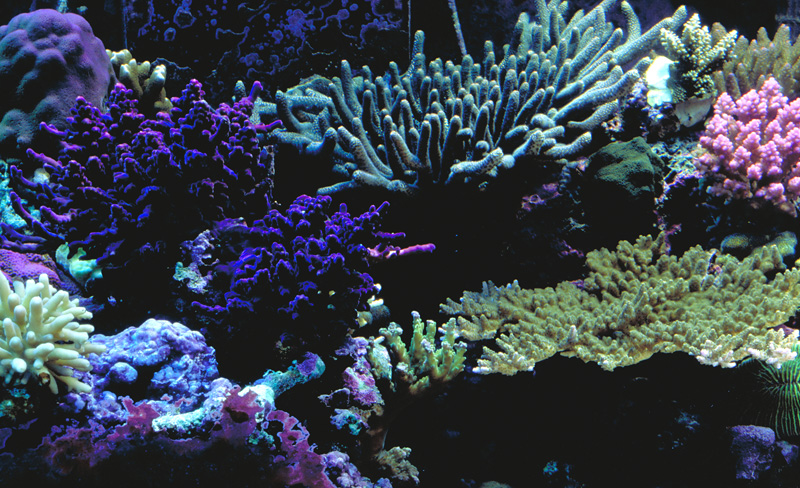
The 180A reef of Steve Tyree in late 1995. This group of corals includes
the Purple Monster on left.
The authors first Table Acropora in lower right. The authors
first Acropora millepora in upper right center.
Also what Steve called the Blue Porites
is located in upper left. At the time a very rare and incredible coral.
Additional Information and Clarification
Thought I would add some additional information about the history of the whole
situation back then in the 1990's. So I had acquired the first Acropora colony back
in June 1992 and was very successful. We had some failures though with the Fiji Loripes,
but were still acquiring Acropora from the Solomons and Indonesia. Moved to Aliso Viejo
California in late 1994, and around 9 months later made probably the first all SPS presentation
to Macna at Louisville in 1995. Was very excited to tell people about my success using
the Berlin Method for maintaining Acropora. My presentation there was the last one that
day and they just let me go. Spoke for nearly close to 2 hours. People keep wanding in
from the bar with drinks in their hands, surprised I was still speaking. But hey, there
was a lot of information to convey and a lot of images to show. To some in the audience,
colorful small polyped stony corals such as these, had never been seen before. And getting
colorful images of captive corals to slide film, was not easy at the time.
Then of course the RTN debacle occurred in 1996. And it more or less made me feel like
crap. Here I went and told people about keeping Acropora in 1995, and as Mike Paletta
said at Macna Denver, some people would listen to speakers back then and go run out and
do what they suggested. So I was sitting back during the RTN fiasco watching tanks crash
all over the country and I was muzzled. Could not even help them publicly. All due to the
unsanitary holding facilities in Fiji at the time. So as my Aliso Viejo business was
failing, I was just importing some Solomons and Indonesian Acropora for awhile, but
eventually even that could not support the Aliso Viejo facility. Hooked up with Leng
Sy, and we tried to do a wholesale Acropora tranship business, but that never got off the
ground and failed in a few months. Thought that it was just due to RTN affecting the
entire industry, but I now know it was more then just that. The industry insiders had
spread that false rumor about RTN coming from my Aliso Viejo facility. So obviously that
rumor had also affected my other coral business ventures back then.
It was during those last few months of 96/97 in Aliso Viejo, that me and Bill Schroer of
Piece of the Reef first hooked up. He was my customer and he had opened a store in Rancho
Cucamonga. He had jumped in after the RTN debacle pretty much wiped out the SPS Acropora
market. Bill was the first big sps fragment buyer. He would come down to my facility and
actually buy little fragments of Acropora and Montipora. Sometimes smaller then a dime.
He placed them in his store reef and grew them out. His demand and pushing for fragments,
would eventually help kick off the Purple Monster and Limited Edition craze. Back during
1996 and 1997, there was no wide spread graphic internet for the coral business. It was
all BBS derived text based email lists.
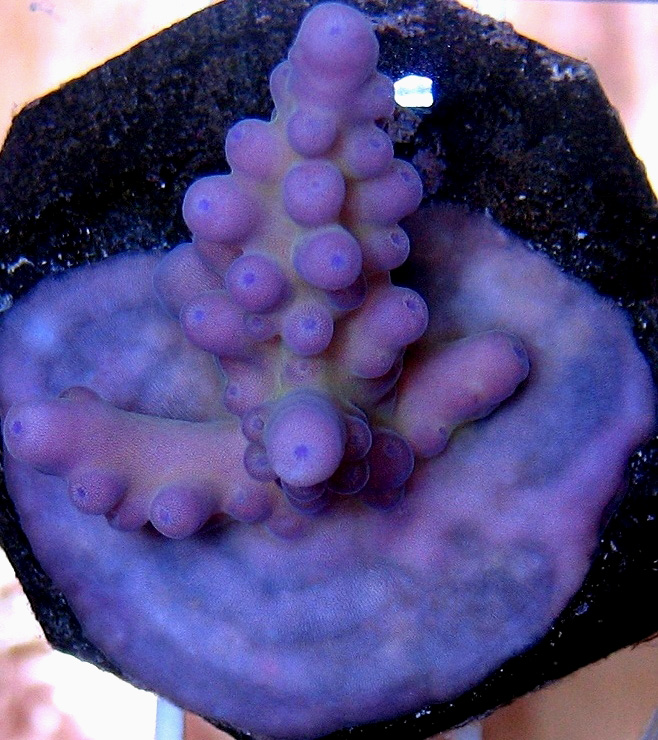
A Purple Monster fragment grown by Steve Garrett of Garrett's Acropolis
in 2011.
That was about 15 to 16 years after the coral had first arrived to captivity.
This shows the coral in its normal coloration.
Eventually I was forced to downsize to a small shop located in Vista California (North
San Diego County). And while there continued to have financial problems as Y2K was coming
and well the old RTN fiasco was still fresh in a lot of peoples minds. Had to start
selling off stuff to pay the bills. Sold some tanks and even had to sell my big giant RK2
skimmer. Struggling financially though helped me to discover the cryptic based all natural
filtration method in the US. But keeping Acropora with the Berlin method had not been a
problem for me. Had been there and done that. 92-98. My next challenge would be keeping
them without a skimmer. Eventually though Y2K took out that Vista facility. No one was
mail ordering, (as we called it back then), Acropora during the last 4 months of 1999.
They were all buying cans of pork and beans waiting for the societal collapse that never
came.
So keeping Acropora without a skimmer has been what I have been doing and researching
since 98/99. And no you should not go run out and try. It is not easy, but it is possible.
Actually ran without a tank for close to a year durng that Y2K craze. People thought I
had more or less left the scene 98 through 00, but I was actually doing research with low cost
methods. Not my choice, but that was were life had led me. Bill let me setup a tank in his
store and the cryptic research continued. During that time I was more or less selling
corals and frags from Piece of the Reef online to mail order customers. The first web
page based selling stores were springing up during that time. And Bill had reacquired
the Purple Monster from Cameron Azad who had kept it alive and grown it into a decent
sized colony. Bills's initial Purple Monster fragment had been lost when someone put some
contaminant in his store reef. Probably bleach. He also lost one of the only very few
fragments made from the original Leng Sy cap with that accident. Bill bought Cameron's
entire colony and we then began to resell Purple Monster fragments at the $50 and up price
point.
That Piece of the Reef store eventually failed due to the high cost situation in
California. Bill moved the store to a lower cost industrial location and eventually I
took over that second facility. Bill would leave the country and begin coral and fish
collecting work with an exporter in Ponape. During that transition is when and where the
online Reeffarmers web site began with its Limited Edition based reservation system. And
because demand was crazy back then, and people would wonder if I was their friend if they
got a 4 year out reservation, I had to over book the reservations. My plan at that time
was to have Tracy Gray and Steve Elias grow additional frags to supply the over booked
demand. But unfortunately, both eventually had system crashes due to automation failures.
But hey, my low cost cryptic based method, just kept on chugging. Remained in that old
Piece of the Reef facility until eventually making the move to Texas in 2012.
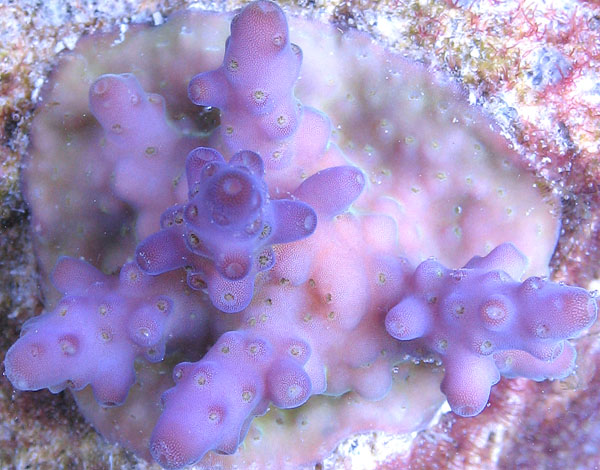
This Purple Monster fragment from 2006 shows the lighter version of the coral.
In very strong light the coral can lighten up as we call it in the industry and develop
an almost pink coloration.
It should be noted that the Purple Monster was a difficult coral to
grow and maintain over time in captivity.
It is very sensitive to changes in calcium carbonate
or KH levels.
Steve Tyree
Happy 2015 New Year !
Updated and Edited 8:30 pm CST January 1st 2015
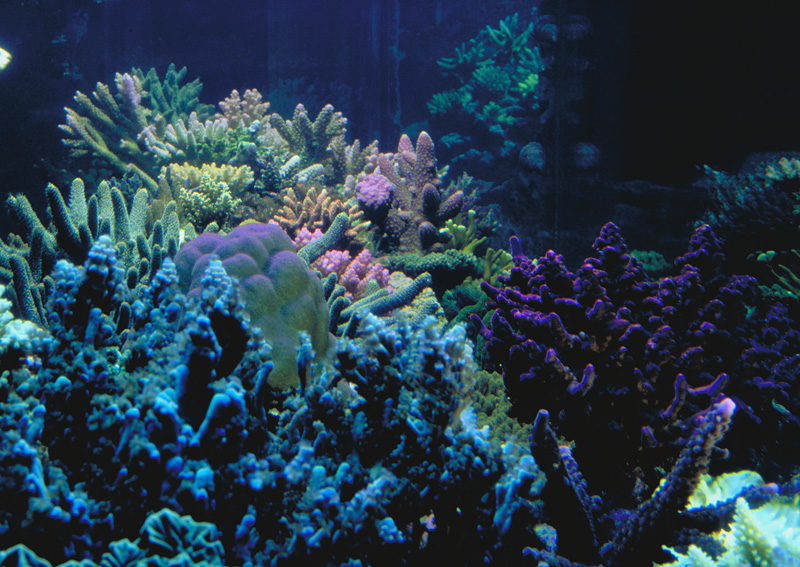
An end shot of Steve's 180A reef in late 1995. The Purple Monster is in the lower
right.
The top of Steve's original Acropora is in the lower left. It was over 1 1/2 feet tall
at that time.
Some of the corals in the upper back area were very strong light shallow water Fiji corals.
Copyright © 2015 Reeffarmers.com and Steve Tyree All Rights Reserved.







